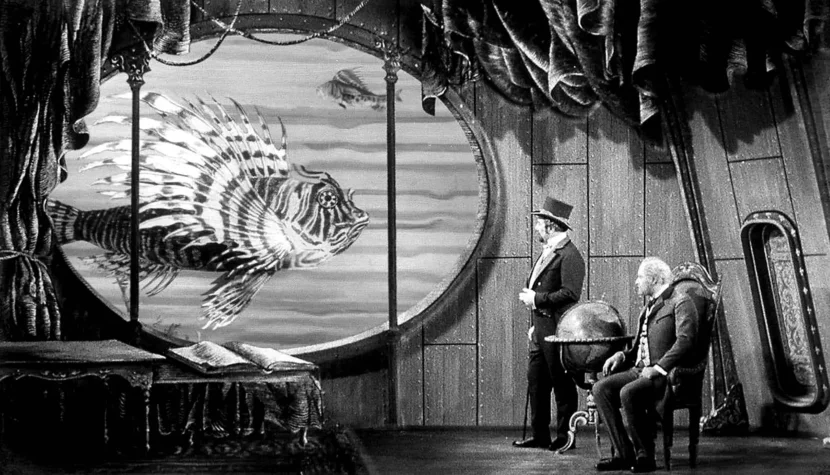INVENTION FOR DESTRUCTION. Science fiction based on 20,000 Leagues Under the Sea?

The late 1950s, and the film’s style resembles silent cinema from the 1920s, except later given sound. Of course, with Karel Zeman, this is intentional, and fortunately, it doesn’t last throughout the entire screening. The idea for the film undoubtedly came from 19th-century adventure and swashbuckling literature, when people dreamed of conquering the depths of the oceans and the sky—in the sense of the Earth’s atmosphere. Today, it’s more of a curiosity within the science fiction genre rather than a production that provides lively entertainment, but for anyone who loved Jules Verne, Joseph Conrad, or Herman Melville, some moments of “Invention for Destruction” will certainly evoke nostalgia. I’ve come across opinions that Zeman’s film is the best or one of the best science fiction productions in Czech cinema. I don’t share that view.
However, this doesn’t stop me from appreciating the historical value of the production. “Invention for Destruction” is a partially animated feature film, full of special effects that the creators employed at almost every moment. Today, this can be seen as bold, considering they had only analog tools. Zeman used optical effects, drawn backgrounds, and photomontages almost in the same way we use green screens today, creating minimal physical sets. Thus, in “Invention for Destruction”, all more complex shots, including the wide ones, were created in the studio—which is noticeable, but it still contributes to the atmosphere of a much older production than a film from the late 1950s. This approach also helped cut costs, as it was enough to draw a sailboat or a castle, not to mention a submarine, instead of using real objects and locations. At that time, underwater filming was out of the question, so the animated and scenic effects invented by Zeman’s team were the only option.

The plot is also characteristic of this director. The story is the diary of an assistant to a professor-inventor who manages to create a weapon of mass destruction capable of changing the course of the world. Naturally, he believes his achievement will be used peacefully, but of course, we know humanity. The narrator was also aware of this. Zeman knew it too, which is why he introduced a villain resembling Captain Nemo in some traits. However, as far as I remember, the commander of the “Nautilus” was not such a common and one-dimensional criminal. Unfortunately, in “Invention for Destruction”, there wasn’t enough screen time to portray Count Artigas in more detail, in a less black-and-white way. The film lasts only an hour and 19 minutes. It’s important to understand that at that time, this was quite long, especially given the significant number of special effects. Imagine having to paint the texture of castle walls by hand, create a rolling sea, draw and animate animals, ships, the ocean floor, and the devilish invention itself. There was no way to use computer editing back then, so creating a scene took weeks. The similarities to Nemo, Professor Aronnax, and Conseil are no accident.
“Invention for Destruction” can be considered a very loose adaptation of “20,000 Leagues Under the Sea”, although it is actually an adaptation of another Verne novel, “Facing the Flag”. It’s a later work where the writer returns to the world created for Captain Nemo. What’s worth emphasizing is that Zeman made a loose adaptation but with undeniable devotion to Verne, which leaves a lasting impression, even if one is unlikely to revisit the film purely for entertainment. This is not a criticism, but a normal lack of interest in the past, expressed by generations born in other times and familiar with a different kind of science fiction cinema aesthetics. Maybe if Zeman had paid more attention to the dramatic layer of the production, changing the music to something less slapstick-like—reminiscent of the music played by a pianist in silent films—it would be much more watchable today. The underwater scenes’ soundtrack is far more balanced and ominous, especially when the giant octopus appears. The frame where the water turns ink-colored, even though only black is visible, still impresses me, or the frame of the suffocating diver whose hand can’t turn the valve, and then butterflies appear… Unfortunately, the atmosphere drastically changes after that, and once again, you hear that unbearable harpsichord along with oboes and bassoons. And so it continues until the end, and when a woman appears in a lavishly drawn chamber, the film suddenly veers sharply from science fiction toward fairy tale.

These, however, were the beginnings of science fiction cinema, allowing it today to tell stories of destruction caused by artificial intelligence. In comparison to “Journey to the Beginning of Time“, “Invention for Destruction” is much less linear. The sensational and dramatic layers are there. The scene settings change, and the characters function within a coherent plot, not an educational premise that during the screening, the viewer must learn about as many prehistoric species as possible. The viewer is also treated to an exciting finale in the aeronautical style straight out of “Around the World in 80 Days”. There’s also a moment of reflection on the state of humanity, given that a weapon of mass destruction can be something so thoughtlessly desired by it.

